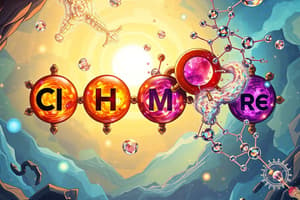Podcast
Questions and Answers
Az ötvözetek olyan anyagokat hoznak létre, amelyek tulajdonságai eltérnek az egyedi ______-ek tulajdonságaitól.
Az ötvözetek olyan anyagokat hoznak létre, amelyek tulajdonságai eltérnek az egyedi ______-ek tulajdonságaitól.
komponensek
Az inorganikus kémia és a fémszerkezetek egy fontos része a tiszta fémetek kinyerése az ______-ból.
Az inorganikus kémia és a fémszerkezetek egy fontos része a tiszta fémetek kinyerése az ______-ból.
ércekből
Az ______ olyan értékes ásványi anyagokat tartalmaz, amelyek be vannak ágyazva egy nem kívánatos anyag mátrixába.
Az ______ olyan értékes ásványi anyagokat tartalmaz, amelyek be vannak ágyazva egy nem kívánatos anyag mátrixába.
érce
Az ______-ból először kisebb darabokra kell törni, néha még finom porrá őrölésével is.
Az ______-ból először kisebb darabokra kell törni, néha még finom porrá őrölésével is.
A fémekkel való kölcsönhatás megértése létfontosságú, mert például a ______ akkor következik be, amikor egy fém reakcióba lép környezetével, ami romlást okoz.
A fémekkel való kölcsönhatás megértése létfontosságú, mert például a ______ akkor következik be, amikor egy fém reakcióba lép környezetével, ami romlást okoz.
A fémek biológiai rendszerekben játszanak lényeges szerepet; néhány az élő szervezetek számára fontos ______, míg mások mérgezést okozhatnak, ha túlzottan fogyasztják.
A fémek biológiai rendszerekben játszanak lényeges szerepet; néhány az élő szervezetek számára fontos ______, míg mások mérgezést okozhatnak, ha túlzottan fogyasztják.
Az ______ a tudomány ága, amely a szilárd testek és folyadékok anyagi szerkezetét, tulajdonságait és reakcióit tanulmányozza.
Az ______ a tudomány ága, amely a szilárd testek és folyadékok anyagi szerkezetét, tulajdonságait és reakcióit tanulmányozza.
Az ______ különböző területeket foglal magában, mint az organikus kémia, a fizikai kémia, az analitikai kémia, a biokémia és az anorganikus kémia.
Az ______ különböző területeket foglal magában, mint az organikus kémia, a fizikai kémia, az analitikai kémia, a biokémia és az anorganikus kémia.
Az ______ kémia a nem szénatomokat tartalmazó elemek kémiai viselkedését tanulmányozza, például a hidrogén, oxigén, nitrogén, klór, bróm, jód és egyéb nem szénatomok, mint például a bor, szilícium, alumínium, réz, vas, króm, stb.
Az ______ kémia a nem szénatomokat tartalmazó elemek kémiai viselkedését tanulmányozza, például a hidrogén, oxigén, nitrogén, klór, bróm, jód és egyéb nem szénatomok, mint például a bor, szilícium, alumínium, réz, vas, króm, stb.
A ______ kapcsolódik a kohászathoz, amely az anyagok fizikai és kémiai tulajdonságait tanulmányozza.
A ______ kapcsolódik a kohászathoz, amely az anyagok fizikai és kémiai tulajdonságait tanulmányozza.
Az ______ természetes elemek, amelyek jó vezetők az elektromosság és a hő terén, a Föld kérgében megtalálható ásványokban találhatók.
Az ______ természetes elemek, amelyek jó vezetők az elektromosság és a hő terén, a Föld kérgében megtalálható ásványokban találhatók.
Az ötvözet egy vagy több ______ keveréke, vagy olyan fém, amely más elemekkel, például nemfémekkel kombinálva van.
Az ötvözet egy vagy több ______ keveréke, vagy olyan fém, amely más elemekkel, például nemfémekkel kombinálva van.
Study Notes
Overview of Chemistry and Inorganic Chemistry
Chemistry is the branch of science that deals with the composition, structure, properties, and reactions of matter. It's a vast field encompassing various areas, including organic chemistry, physical chemistry, analytical chemistry, biochemistry, and inorganic chemistry. For this article, we will focus on inorganic chemistry and its relationship to metals.
Inorganic chemistry studies the chemical behavior of elements that do not contain carbon atoms, such as hydrogen, oxygen, nitrogen, chlorine, bromine, iodine, and other non-carbon elements like boron, silicon, aluminum, copper, iron, chromium, etc.. These elements combine with each other to form compounds with diverse properties. Understanding their bond formation and reactivity helps us understand the world around us better.
Metallurgy is closely related to inorganic chemistry. Metals, which are usually defined as good conductors of electricity and heat, are naturally occurring elements found in minerals throughout the Earth's crust. They have been used by humans since ancient times due to their many useful properties. Techniques developed over thousands of years allowed humans to extract metals from ore using processes such as smelting and refining.
The discovery of alloys has also played a significant role in the advancement of metallurgy. An alloy is a mixture of two or more metals, or a metal combined with other elements such as nonmetals. This combination can produce materials with properties different from those of the individual components. Examples of common alloys include steel (an iron-based alloy), brass (a zinc-copper alloy), and bronze (a tin-copper alloy).
One important aspect of inorganic chemistry and metallurgy is the extraction of pure metals from ores. Ore contains one or more valuable mineral resources embedded in an unwanted matrix of materials, often referred to as gangue. To obtain the desired metal, the ore must first be crushed into smaller pieces, sometimes even grinding it down to a fine powder. Then, specific chemicals are added to dissolve out the metal while leaving behind impurities. Finally, these metals are separated through techniques like electrolysis, which involves passing electric current through a solution containing the metal and its ions, depositing the metal onto a cathode.
In addition to human uses, understanding how metals interact with their environment is crucial. For example, corrosion occurs when a metal reacts with its environment, causing deterioration. Corrosion protection measures, such as painting or coating, prevent this degradation. Additionally, metals play essential roles in biological systems; some are vital nutrients for living organisms, while others can cause poisonings if consumed in excess.
In summary, studying inorganic chemistry allows us to gain insight into the fundamental building blocks of matter and their interactions. By exploring metals specifically, we uncover the fascinating properties that make these elements so versatile and integral to our daily lives.
Studying That Suits You
Use AI to generate personalized quizzes and flashcards to suit your learning preferences.
Description
Explore the world of inorganic chemistry and metallurgy, focusing on elements without carbon atoms, their bond formation, reactivity, and the extraction of pure metals from ores. Learn about the significance of alloys, corrosion, and the essential roles of metals in both industrial and biological systems.




